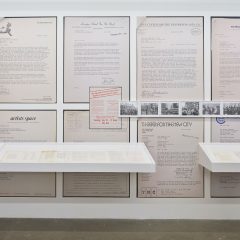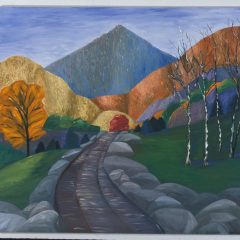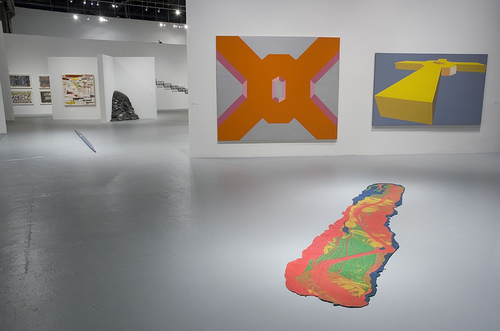
Lynda Benglis’ Odalisque (Hey Hey Frankenthaler) is on the floor; her For Carl Andre is the nearly black blob filling a corner in the left rear. Installation view of WACK! Art and the Feminist Revolution at The Geffen Contemporary at MoCA, 2007, photo by Brian Forrest, courtesy The Museum of Contemporary Art, Los Angeles
It’s International Women’s Day. I know because I’ve been listening to all those songstresses on WXPN, you know, Joan Armatrading, Lorena McKennitt, etc, etc. So it seems like the perfect day to bring you news from WACK! Art and the Feminist Revolution, an exhibit of feminist art of the 60s and 70s at LA MoCA, which opened last weekend. The exhibit purports to set the record straight on the mega-influence that feminist art has had on what gets made today and how it gets made.
Not that the exhibit tells you the descendants. It just presents our forebears.
It’s a mighty gray show, literally, packed with text, charts and diatribes. After all, overcoming ostracism is serious business and that was what happened in the ’60s & ’70s–and before. Women were mostly invisible in the art world and in the business world. And the show does open the discussion about the influence of the women of that era.
The Penelope weaving a web metaphor has certainly become part of the art world as we now know it, but prior to Eva Hesse, Faith Wilding and Lygeia Clark (who wove giant rubber bands into nets–sort of the like the cargo nets all cars come with today) there was no Ernesto Neto. We already know that the Minimalist boys’ version of multiples and Hesse’s version have both become standard for art-making, with even such male multiples gurus as Allan McCollum focusing on the individual–but not necessarily the biomorphic–in the multiples he creates.
I could have used a little less of the take-your-medicine side of the show. I wasn’t too happy watching videos of young women discussing their menstrual cycles, but really, that was radical at that time. Fortunately, I went to the show with my friend Susan, who participated in the consciousness raising of the era, and who used to be a sex educator. She felt like the show brought her back to that time. We both were amused by Mary Kelly’s Postpartum Documents–diaristic charts, schedules and samples of her baby’s intake and excretions; it reminded us of our desperation in trying to plan a moment for ourselves as we clock-watched to meet the new baby’s needs.
Another gray piece that stood out in a sea of gray was Adrian Piper’s Political Self Portrait series of memoirs about race (1979), surely the ancestors for Jayson Musson’s texty black-and-white posters on race and politics and class.
But ultimately, what grabbed me were the pieces that popped with color–like Lynda Benglis‘ Odalisque (Hey Hey Frankenthaler) from 1965, a slick pour of sexy paint colors that spread across the floor, a tongue with meandering edges. Slurp. I can think of any number of currently active artists making work that involves pouring. Locally, there’s Stuart Netsky and John Manteau, for starters. And we can take the history back to another woman just one generation earlier, and that would be Helen Frankenthaler. Her other knockout piece in the show, For Carl Andre (1970), is in two shades of gray. Here I have to refer you to the John Maycheck piece that Roberta posted about after the art fairs. I’d say this is a direct descendant. Maycheck, like Benglis, pours to create something that is decorative and sexy and a cross between macho and voluptuous. Benglis adds the touch of declaring the lineage of her work in the titles. It’s at once a sharing-of-the-credit salute and a listen-to-me shout.
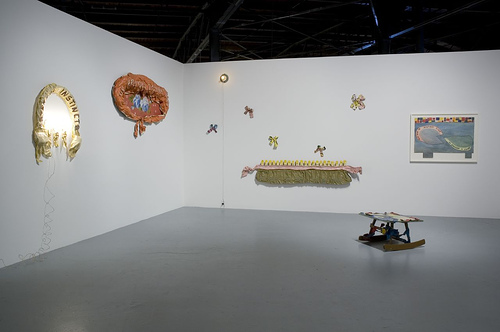
All of these pieces express Ree Morton’s ambivalence about motherhood. I want to thank Sid Sachs for calling her work to Philadelphia’s attention a few years ago at Rosenwald-Wolf. Installation view of WACK! Art and the Feminist Revolution at The Geffen Contemporary at MOCA, 2007, photo by Brian Forrest, courtesy The Museum of Contemporary Art, Los Angeles
The other color queen of the show was Ree Morton, whose ironic ribbons and petals expressed perfectly the ambivalence of motherhood. She also incorporated words much the way that half the art world does these days–as integral parts of the visual message. I loved looking at her imagery, but I also loved the way her words worked. And I loved the physicality of her irony (we’re all still doing this). Also, Martha Rosler’s collages–Body Beautiful, Beauty Knows Know Pain–brings up methods and themes that are still in the air.
I have to say that including the razor sisters–Orlan and Marina Abramovic–seemed wrong to me. Theirs is not art about women’s liberation–it’s art of oppression, self-hatred, and self-destruction–the antithesis of what feminism was all about. And it’s also exhibitionism at its most questionable. I suppose the questions here are not all that different from the question about whether hookers have taken control of their bodies or are doing something that’s really self-loathing. I have to go with the latter. I get the other side; I just don’t share it.
The show, which includes work by more than 100 artists offers a lot to look at–and a lot not to look at. I suppose you can argue that if 18-year-old men can make art about and with their penises, then women can do it with their vaginas. In those days, even naming the body parts was a transgression. But body parts without other content just don’t hold my interest–take that Judy Chicago. Thank goddesses for a little humor from VALIE EXPORT –who used body parts to great transgressive effect–and from the Gorilla Girls. Even Yoko Ono demurely clad in a bra got a laugh out of me in her video Freedom, performing a 1-minute striptease that was tease without the strip.
A word about the name of the show. It’s got a nice Pop! sound. But it’s also a slap. It’s the ladies saying, don’t tread on me.
Space for Andrea Zittel
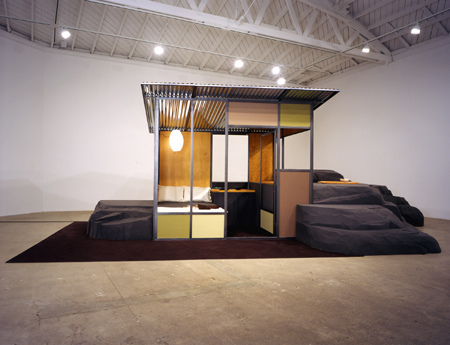
A-Z Homestead Unit from A-Z West, with Raugh Furniture, 2001 – 2004, Powder-coated steel, birch paneling with paint and polyurethane, corrugated metal roof, sculpted foam furniture, fleece blanket, A-Z Fiber Form Garment (felted wool), pillows with pillowcases, A-Z Fiber Form Containers (felted wool), camp-stove with tea kettle and water containers.
After we saw this show, we walked into Andrea Zittel’s one-woman exhibit, Critical Space, also at LA MoCA’s Geffen Center. It’s a fabulous show, and it is work that owes her independence and quirkiness and her welcome into the artworld to these women in WACK!
Zittel’s portable life-in-a-box and life-in-a-container constructions live between the pop culture of the trailer-trash life and the impractical artiness of survivalist architecture like Thomas Hirschhorn’s Cavemanman. She is positioned in the desert among kooks and isolates, but somehow, by rethinking all the rules, she has created her own neighborhood and a sort of cozy environment for herself (or maybe not so cozy, but certainly snug). She has opted out of the commercial culture and her work implicitly criticizes it. Yet if you visit her web site, it’s about selling.
The thing that struck me as I watched a slide show she had presented previously at the 2004 Whitney Biennial is how plugged in she is to the internet and to all the electronic advantages. I wonder how she got her internet access.
The body of work is overwhelming and unique. Zittel has made her life her art and her art her life.



